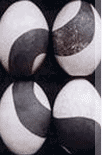I have been
involved in pottery making since the 70’s and the most difficult part for
me has always been the question of colours and finishing. Consequently I
decided to attend the workshop of Vilma Villaverde for a course in glazes and
Raku, strangely enough the firing was made in my studio.
The course convinced me that this was my future, while the burning in my
electric kiln helped me to pluck up courage and handle it without fear, opening
and closing the kiln at 900º, manipulating the tongs or clips, etc. All
this has been a great experience for me and helped in the development of my
works and profession.
|
Brief history of this
technique
Raku means happiness, enjoyment, pleasure, satisfaction. There are two versions
regarding the way in which this way of firing pottery began, one way says that
around 1550 after a huge natural disaster in Japan a quantity of Korean
ceramists were called to keep reconstruct the houses, one of them was Chojiro,
son of Ameyra. As they could not produce fast enough, they began removing the
tiles while hot with pincers, thus discovering that the tiles withstood the
thermal impact, thanks to the great amount of sand contained in the mixture.
Another version says that Chojiro, due to the great demand of teacups for the
tea ceremonies, started to remove them while incandescent with the help of
pincers.
I personally uphold the second theory, since at that time the custom was for
each feudal master to possess various sets of crockery, with a headman to
organize the ceremonies, and choosing a ceramist to produce the crockery.
Sen-no-Rikyn, great Master of the tea ceremony on Kyoto took Chojiro as his
protégé, and presented him to Hideyoshi, great Feudal Master for
whom he worked all his life.
The original colours used were black (Kuro Raku) and red (Aka Raku): adopted not
only al being easy to obtain, one from a stone in the river Kamo, and the other
form the iron oxide, but because of the contrast with green tea.
At the beginning of the last century, a British man called Bernard Leach visited
Japan and relates in his book “The ceramists Manual”, that he had
the opportunity to become acquainted with this technique and was much taken by
it. He dedicated his stay in the country to it, and on his return to England
made it known as he had learnt it.
Later a North American ceramist introduced it to the Unites States, reaching
Paul Soldner, “father” of occidental Raku, and made the changes
which today characterize this technique: the reduction and the smoking.
|

